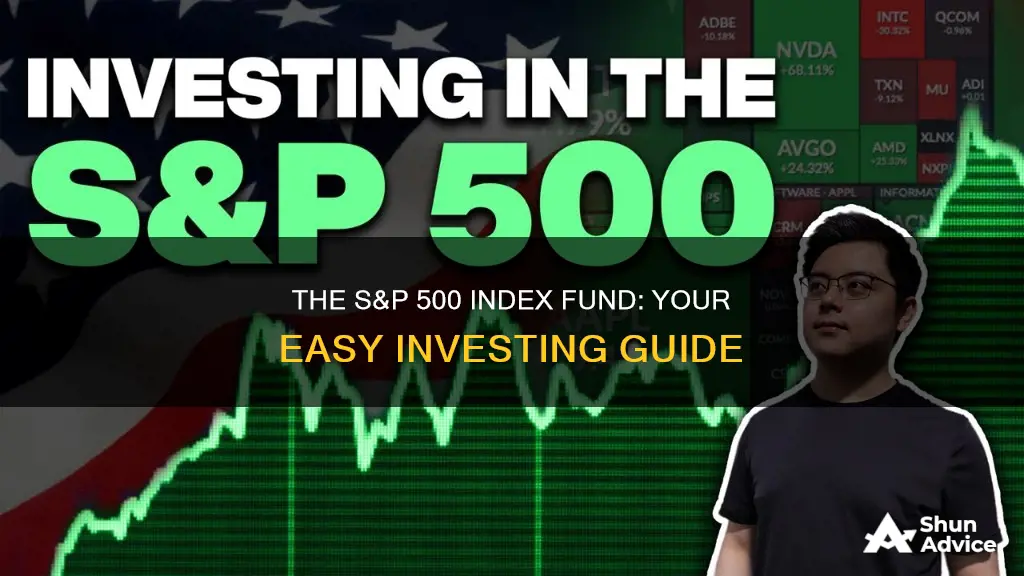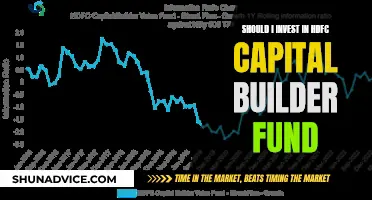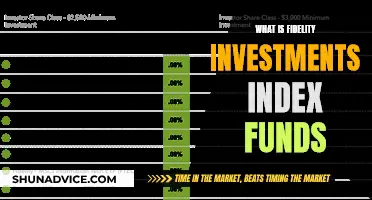
The S&P 500 is a stock market index that tracks the performance of the 500 largest US companies by market capitalisation. It is widely considered to be a good indicator of the health of the US stock market and the US economy.
Because the S&P 500 is an index, you can't invest directly in it. However, you can invest in securities that allow you to invest in the S&P 500. There are a few options for this:
- Mutual funds
- Exchange-traded funds (ETFs)
- Separately managed accounts (SMAs)
- Individual stocks
Mutual funds and ETFs are generally considered to be the easiest options for investing in the S&P 500. They are also the cheapest options, with low expense ratios and low minimum investments.
| Characteristics | Values |
|---|---|
| What is the S&P 500? | The S&P 500 is an index that tracks the performance of the 500 largest US companies by market capitalisation. |
| How to invest in the S&P 500 | You can't invest directly in the S&P 500. However, you can buy individual stocks of S&P 500 companies, or buy an S&P 500 index fund or ETF. |
| Benefits of investing in the S&P 500 | Instant diversification, no intensive stock-picking research is required, consistent long-term returns, ideal for beginners. |
| Risks of investing in the S&P 500 | Dominated by large-cap companies, short-term volatility, no exposure to international companies. |
| How to choose an S&P 500 index fund | Consider the expense ratio, minimum investment, dividend yield, and inception date. |
| Steps to investing in the S&P 500 | Do your homework, choose an investment vehicle, open an investment account, invest regularly, monitor and rebalance. |
| Costs associated with investing in the S&P 500 | S&P 500 investment funds tend to have low expense ratios compared to actively managed funds. |
| S&P 500 index fund vs ETF | ETFs are generally more liquid, ETF buy-ins are often lower than mutual funds, but fewer brokerages allow fractional shares of ETFs. |
What You'll Learn

Understand the S&P 500 index fund
The S&P 500 index fund is an investment vehicle that tracks the performance of the S&P 500 stock market index, which is a group of 500 large US companies. These companies are selected based on factors such as market capitalization, liquidity, and financial viability, and the index is maintained by the US Index Committee, part of S&P Dow Jones Indices. The S&P 500 is considered one of the best measures of Wall Street performance and a reliable indicator of the overall health and direction of the US stock market.
Because you can't invest directly in the S&P 500 index itself, an S&P 500 index fund offers a way to gain exposure to the index's performance. These funds aim to replicate the returns of the S&P 500 by purchasing the stocks of all the companies within it, in proportion to their market capitalizations. This passive management strategy means that the fund doesn't need to actively decide which stocks to buy or sell, reducing costs for investors.
There are two main types of S&P 500 index funds: mutual funds and exchange-traded funds (ETFs). Mutual funds are typically bought and sold at the end of the trading day and have higher management fees, while ETFs can be traded throughout the day like stocks and often have lower fees. Both types of funds offer instant diversification and are considered less risky than purchasing individual stocks directly.
When choosing an S&P 500 index fund, it's important to consider factors such as the expense ratio (the annual fee expressed as a percentage of your investment), the minimum investment required, and the dividend yield. Additionally, investors should be aware of the potential tax consequences of capital gains distributions from mutual funds, which may result in a tax bill even for buy-and-hold investors.
Overall, the S&P 500 index fund is a popular investment choice due to its low costs, broad diversification, and long-term performance.
A Guide to SWP Mutual Fund Investment Strategies
You may want to see also

Compare index funds and ETFs
Index funds and ETFs (exchange-traded funds) are two simple ways to invest in the stock market. They are similar in that they both pool investors' money to create a large, professionally managed portfolio that may contain stocks, bonds, and other assets. However, there are some key differences between the two.
Trading Mechanism
Index funds can only be bought and sold at the end of the trading day, based on the fund's net asset value (NAV). ETFs, on the other hand, trade throughout the day on a stock exchange, just like stocks, and their price fluctuates based on supply and demand. This makes ETFs more suitable for active investors.
Minimum Investment
ETFs typically have a lower minimum investment than index funds, sometimes allowing investors to buy a single share. Index funds often have a minimum investment requirement, although these may be dropped for investments through payroll.
Taxation
ETFs are generally more tax-efficient than index funds because of their structure. ETFs use an "in-kind" creation and redemption process, which minimises capital gains distributions that would otherwise trigger tax events. Index funds, on the other hand, may generate capital gains when the fund manager sells holdings to meet redemptions, potentially leading to a tax liability for investors.
Fees
Management fees tend to be lower for ETFs. However, buying and selling ETFs may incur trading fees, depending on the brokerage. Index funds typically do not have shareholder transaction costs, but they may have higher expense ratios than ETFs.
Liquidity
Since index funds are bought and sold at the end of the trading day, they have less liquidity than ETFs.
Suitability for Long-Term Investors
Index funds could be more suitable for long-term investors who are not looking to buy or sell throughout the trading day and are not concerned with minimising transaction costs.
Suitability for Higher Tax Bracket Investors
If investing outside of a retirement plan, ETFs could be preferable for those in a higher tax bracket as they do not trigger capital gains taxes when other investors cash out.
Unconstrained Bond Funds: Diversifying Your Investment Portfolio
You may want to see also

Choose an investment account
There are several types of investment accounts you can use to buy an S&P 500 index fund. These include a taxable brokerage account, a 401(k), or an IRA. You can also use a robo-advisor platform.
If you don't already have a brokerage account, you'll need to open one to buy investments. You can use the money you deposit into the brokerage account to purchase S&P 500 stocks or funds, which will then be held within that account.
If you're investing for retirement, consider investing in the S&P 500 through a 401(k) or IRA, as these come with added tax benefits.
When choosing a broker, look for one that offers a wide range of ETFs and mutual funds without trading fees. You should also consider the broker's transaction fees, fund selection, convenience, and impact investing options.
- Determine your investment goal: Are you investing for the short term or long term? If you're looking for a short-term investment, you may be more interested in certificates of deposit, savings accounts, or money market funds. If you're investing for the long term, particularly for retirement, index funds may be a better option.
- Research index funds: Consider factors such as company size and capitalization (small-, mid-, or large-cap indexes), geography, business sector or industry, asset type, and market opportunities.
- Pick your index fund: Compare the costs of different index funds, as low costs are one of the biggest selling points. Look for funds with low expense ratios and avoid sales loads, which are commissions charged by fund managers.
- Decide where to buy your index fund: You can purchase an index fund directly from a mutual fund company or a brokerage. Consider factors such as fund selection, convenience, trading costs, and impact investing options when choosing a provider.
- Open your investment account: Choose a broker that matches the type of investments you plan to make and offers low fees. You can open an account in 15 minutes or less.
- Determine your investment budget: Figure out how much you can afford to invest regularly and set up your account to transfer money from your bank or paycheck on a weekly or monthly basis.
- Buy the index fund: Go to your broker's website and set up the trade by inputting the fund's ticker symbol and the number of shares you want to buy based on your budget.
By following these steps, you can choose an investment account that suits your needs and goals when investing in the S&P 500 index fund.
Axis Small Cap Fund: Smart Investing Strategies for Beginners
You may want to see also

Decide on an investment strategy
There are two main ways to invest in the S&P 500: through individual stocks or through an index fund, such as a mutual fund or exchange-traded fund (ETF).
If you're a beginner investor, investing in an index fund is the ideal option as it provides broad market exposure and diversification at a low cost.
- Expense ratio: This is the cost that the fund manager will charge you over the course of the year to manage the fund as a percentage of your investment. Look for funds with low expense ratios, as this will maximize your returns.
- Sales load: This is a sales commission charged by the fund manager. You should avoid this expense, especially when investing in index funds. ETFs don't charge a sales load.
- Minimum investment: Different funds will have varying minimum investments. Be sure to choose a fund that aligns with the amount you have available to invest.
- Dividend yield: Compare the dividend yield offered by different funds, as this can boost your returns, especially in down markets.
- Inception date: Consider the fund's track record and how it has performed during bull and bear markets.
- Liquidity: If you're an active investor, liquidity may be important. Funds with higher average trading volumes are more liquid, while those with lower trading volumes are less liquid.
Once you've considered these factors and decided on your investment strategy, you can proceed to open an investment account and start investing in the S&P 500.
S&P 500 Index Fund: A Guide for Indian Investors
You may want to see also

Make your trades
Once you have decided on your investment approach, use your chosen investing account to place your trades. Specify the number of shares or the dollar amount you want to invest.
If you are investing in individual stocks, you will need to purchase up to 500 different stocks, which can be costly and time-consuming. You will also need to do thoughtful research and stock performance analysis.
If you are investing in an index fund, you can buy an S&P 500 index fund through a mutual fund or ETF. The latter is ideal for beginner investors since they provide broad market exposure and diversification at a low cost.
If you are investing in an ETF, you can buy shares in any or every company in the S&P 500. However, this requires a substantial investment, as well as the need to rebalance holdings to adjust for changes in companies' relative market capitalisations.
Monitor and rebalance your investments
Keep an eye on your investment and review it periodically. The S&P 500 is a broad index, so it is important to ensure that your portfolio remains diversified. Rebalance your holdings if necessary to maintain your desired asset allocation.
Venture Capital Funds in India: A Guide to Investing
You may want to see also
Frequently asked questions
The S&P 500 is an index that tracks the performance of the 500 largest companies in the U.S. by market capitalization. It is considered a good indicator of the overall health of the U.S. stock market.
You can't invest directly in the S&P 500 index itself, but you can buy individual stocks of companies in the index or invest in an S&P 500 index fund or ETF (exchange-traded fund). You will need to open an investment account with a brokerage platform that offers access to the S&P 500.
The costs depend on the type of fund you choose. S&P 500 index funds typically have expense ratios, which are fees charged as a percentage of your investment. ETFs trade like stocks and have a share price, so you will need to pay the full share price or buy fractional shares. Individual stocks in the S&P 500 vary in cost, with some under $100 and others over $500 per share.
Investing in the S&P 500 can provide instant diversification to your portfolio and has historically provided consistent long-term returns. However, it is dominated by large-cap companies and does not provide exposure to small- or mid-cap stocks or international companies. The S&P 500 is also subject to market volatility and short-term price swings.
When choosing an S&P 500 index fund, consider the expense ratio, minimum investment, dividend yield, and inception date. Compare these factors across different funds to find the one that best aligns with your investment goals and budget.







